This post may contain affiliate links. Please read our disclosure policy.
CrossFit Inc., founded by Greg Glassman and Lauren Jenai in 2000, has since emerged into a global phenomenon that has seen exponential growth over the past decade and a half. In 2007, out of necessity for a centralized forum where prized athletes could compete, the CrossFit Games were born – a sporting event that has increased in participation and viewership with each passing year. But it wasn’t until 2011 when Reebok came aboard as partner that the event really caught on. Yet, the CrossFit name wasn’t the only party to cultivate from that union. Reebok, too, benefited from this unified front, and their since enlarged sneaker following partly has CrossFit to thank.
Though the correlation between CrossFit and sneaker culture hasn’t always been as apparent as the newly released Reebok Nano 5.0, it really never had to be. Numerous brands have exposed their company in a new light through various channels. Diadora did it in the late 80’s and early 90’s in track & field and tennis with athletes like Ben Johnson and Björn Borg. Presently, Under Armour is doing so through golf and dance thanks to combination of Jordan Spieth and Missy Copeland. Reebok went the fitness route, a choice many didn’t deem beneficial years ago.
But if everything valuable rests upon the acceptance of public opinion, very few breakthroughs would exist. Back in August 2005 when adidas purchased Reebok for $3.8 billion, most were apprehensive about the acquisition. Sure, there were rough patches in the early stages. However, those who thought adidas’ move was ill advanced in years past, now wish they pushed their chips towards Reebok and the genius forecasting in the explosion of enlightened fitness regiments.
Aside from their partnership with CrossFit Inc, Reebok also has their hands in deals with Les Mills, Spartan Race and a new venture with UFC. What does it all mean? Well, two things. For starters, this marks a newfound visibility for the brand, one that has non-traditional sneakerheads seeing their product line for the first time. What’s more, this expands Reebok’s resources vastly. Sales were up 9% in the first quarter of 2015 according to the WSJ, allowing the brand to spend more in marketing than ever before – much to their benefit.
In addition, no matter where you are, in cities big or small, you won’t travel far without laying eyes on at least a few CrossFit boxes. Many of these facilities bear exterior Reebok branding, feature their apparel and yes, a range of footwear. Aside from malls, big box retailers and standalone boutiques, Reebok has a brand presence none of their competitors do, giving them a unique edge in discernability. The CrossFit partnership has not only helped boost sales, but it’s also enhanced just how efficiently Reebok markets in a global scale.
With increased revenue Reebok is in a very advantageous position very few companies find themselves in. Having the ability to be creative without limitations is a design team’s dream scenario. The introduction of the Reebok CrossFit Nano Pump Fusion is the perfect example to that end. Joining CrossFit technology with past brand heritage, Reebok is strategically introducing one audience to another.
Closing the gap between their far-reaching consumer base is critical. The hope is that eventually every guy wearing the Nano 5.0 at his local box for an evening workout transitions to the Kendrick Lamar Ventilators for a casual night out, which is already the case for some. But the greater intention is for this juxtaposition to be widespread. Reebok is on their way to achieving this monumental success. Much of which wouldn’t be possible without their association with CrossFit.
It’s been well documented that Reebok no longer contracts new signature athletes in the realm of basketball or football. Their approach, outside of Reebok Classics, has ostensibly shifted. Fitness is it. And for all intents and purposes, it’s proving to be all they need.




